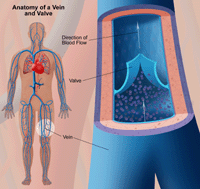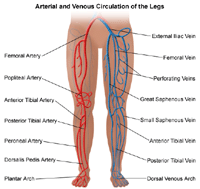Chronic Venous Insufficiency
What is chronic venous insufficiency?
 |
| Click Image to Enlarge |
Arteries carry blood away from the heart, while veins carry blood to the heart. Chronic venous insufficiency occurs when the leg veins do not allow blood to travel back to the heart. Problems with valves in the veins can cause the blood to flow both directions, not just toward the heart. These non-functioning valves can cause blood in the legs to pool. If chronic venous insufficiency is left untreated, pain, swelling, and leg ulcers may result.
Chronic venous insufficiency does not pose a serious health threat, but the condition can be painful and disabling. The condition affects about 5 percent of the US population. It usually occurs in men between the ages of 70 to 79 and in women between the ages of 40 to 49. Estimates are that about 500,000 persons in the US have ulcers of the lower legs that are a result of this condition.
What causes chronic venous insufficiency?
Chronic venous insufficiency is more common among those who are obese, pregnant, or who have a family history of the problem. Individuals who have had trauma to the leg through injury, surgery, or previous blood clots are also more likely to develop the condition.
 |
| Click Image to Enlarge |
Other causes of chronic venous insufficiency include, but are not limited to, the following:
-
lack of exercise
-
smoking
-
deep vein thrombosis (a blood clot in a deep vein, usually in the calf or thigh)
-
superficial vein thrombosis or superficial thrombophlebitis (thrombosis and inflammation of a superficial vein, usually in the legs)
-
varicose veins
What are the symptoms of chronic venous insufficiency?
Symptoms of chronic venous insufficiency may include:
-
swelling in legs and/or ankles
-
tight feeling calves or itchy painful legs
-
pain during walking that stops with rest
-
brown-colored skin, particularly near the ankles
-
varicose veins
-
leg ulcers
The symptoms of chronic venous insufficiency may resemble other conditions. Consult your physician for a diagnosis.
How is chronic venous insufficiency diagnosed?
In addition to a complete medical history and physical examination, diagnostic procedures for chronic venous insufficiency may include:
-
duplex ultrasound - a type of vascular ultrasound procedure done to assess blood flow and the structure of the leg veins. The term "duplex" refers to the fact that two modes of ultrasound are used - Doppler and B-mode. The B-mode transducer (like a microphone) obtains an image of the vessel being studied. The Doppler probe within the transducer evaluates the velocity and direction of blood flow in the vessel.
-
venogram - uses x-rays and intravenous (IV) contrast dye to visualize the veins. Contrast dye causes the blood vessels to appear opaque on the x-ray image, allowing the physician to visualize the blood vessels being evaluated.
Treatment for chronic venous insufficiency:
Specific treatment will be determined by your physician based on:
-
your age, overall health and medical history
-
extent of the disease
-
your tolerance for specific medications, procedures, or therapies
-
your signs and symptoms
-
expectations for the course of the disease
-
your opinion or preference
Chronic venous insufficiency treatment may include:
-
medicationsSeveral types of medications may be used to treat chronic venous insufficiency. Diuretics (medications used to draw excess fluid from the body through the kidneys) may be used to reduce swelling. Pentoxifylline, which improves the flow of blood through the vessels, may be used in combination with compression therapy to help heal leg ulcers.Anticoagulation therapy (blood thinning medication) may be recommended for those persons who have recurring deep vein thrombosis.
-
sclerotherapyFor patients whose condition is more advanced, sclerotherapy may be prescribed. This involves injecting a chemical into the affected veins. The chemical causes scarring in the veins so that they can no longer carry blood. Blood then returns to the heart through other veins and the body absorbs the scarred veins.
-
catheter ablationRadiofrequency and laser catheters can be placed inside varicose veins using ultrasound guidance. This causes the vein to clot, scar, and shrink. (See Varicose Veins.)
-
surgerySurgery is recommended in fewer than 10 percent of people with chronic venous insufficiency. Surgical procedures that may be used to treat the condition include:
-
ligation - tying off an affected vein so that blood no longer flows through it. If the vein and/or its valves are heavily damaged, the vein will be removed ("vein stripping").
-
surgical repair - a vein and/or valves may be surgically repaired, either through an open incision or with the use of a long catheter (hollow tube).
-
vein transplant - transplanting a healthy vein from another body area and replacing the diseased vein with the healthy vein.
-
subfascial endoscopic perforator surgery - a minimally-invasive procedure performed with an endoscope (a small, flexible tube with a light and a lens on the end). The perforator veins (veins found in the calf area) are clipped and tied off. This allows blood to drain into healthy veins and improves ulcer healing.
Click here to view theOnline Resources of Cardiovascular Disease